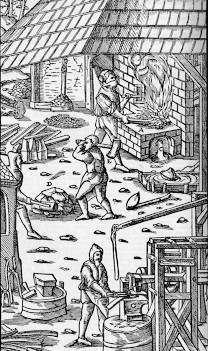Hoover and Agricola
Today, a president's wife meets a great Renaissance mining engineer. The University of Houston's College of Engineering presents this series about the machines that make our civilization run, and the people whose ingenuity created them.
Georgius Agricola lived in the early 16th century. His masterpiece, De Re Metallica, was published in 1556 -- the year after his death. Agricola studied philology and medicine. He first worked as a town physician in the mining region of Bohemia. But there he was drawn to mining and metallurgy. He soon gave up his post and devoted the rest of his life to mining engineering.
De Re Metallica is a very modern book. Agricola avoided the methods of the alchemists. He wrote straightforward and accurate accounts of observed facts. And a shrewd observer he was. The book was sweepingly comprehensive, and it was still the bible of mining engineers on the eve of the Industrial Revolution -- 200 years later. And I mean bible, as some churches were known to chain copies to their altars. That way the clergy could translate parts of its Latin text for miners in their congregations.
Before he entered national politics, President Herbert Hoover had become the outstanding mining engineer of his generation. In 1905 his wife Lou wrote to a Stanford Professor named Branner, who'd taught geology to both Hoovers. Lou had run across a copy of De Re Metallica in London. She wondered if there was an English translation. If there wasn't, she wanted to use her knowledge of Latin to create one.
That was the innocent step into the maelstrom. Lou and Herbert Hoover undertook the job together. They worked every spare hour on it from 1907 until 1912, and what they produced was no mere translation. I have a copy here. It's 670 pages long. A great deal of it is introductory material, footnotes, and appendices. By themselves, these annotations make up the first comprehensive history of mining that'd ever been written.
Agricola had had to invent most of his Latin technical terms, and all the previous German translators had butchered them. Now, with extraordinary care, the Hoovers -- using Herbert's knowledge of mining -- figured out Agricola's intent. They made a whole separate study of Latin and medieval units of measure. Herbert even did laboratory experiments to check Agricola's statements. Together, the Hoovers take us on a guided tour through the complete mining literature before Agricola and much of what followed. These two amateur historians established the entire provenance of the field of mining engineering with brilliant scholarly work.
And it's lovely to look at. Its 289 fine woodcuts not only tell us just what mining was like and how it was done; they also present a microcosm of early 16th-century life. The Hoovers' work stands today as the classic in the history of mining.
I'm John Lienhard, at the University of Houston, where we're interested in the way inventive minds work.
(Theme music)
Agricola, G., De Re Metallica. (tr. by Herbert Clark Hoover and Lou Henry Hoover) New York: Dover Publications, Inc., 1950. (reprint of the 1912 edition.)

(From De Re Metallica, 1556)
Agricola's picture 16th century iron smelting